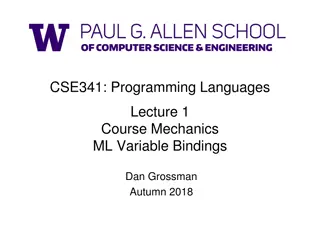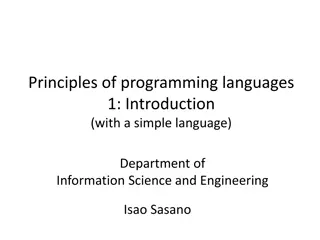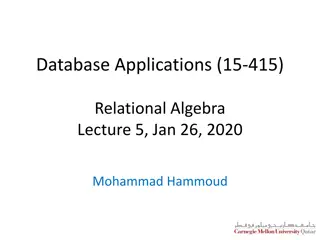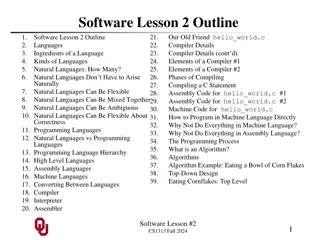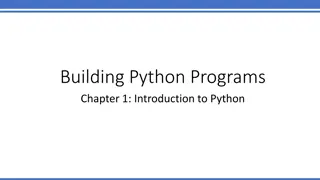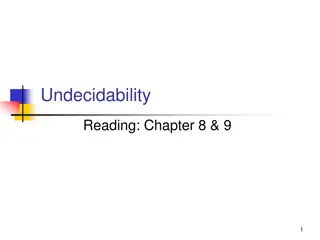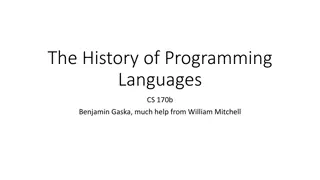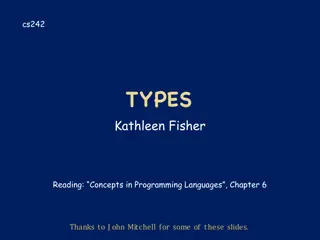Understanding Programming Languages: Levels and Basics
Programming languages facilitate communication between humans and computers, with machine language being the fundamental binary code understood by computers. Different levels of programming languages exist, from low-level machine language to high-level languages like C. Natural languages are meant for human communication, whereas programming languages serve the purpose of computer interaction. Assembly language bridges the gap between machine and high-level languages, requiring an assembler for translation. High-level languages, such as COBOL, enable users to write programs resembling English words and mathematical symbols, independent of machine architecture.
Download Presentation

Please find below an Image/Link to download the presentation.
The content on the website is provided AS IS for your information and personal use only. It may not be sold, licensed, or shared on other websites without obtaining consent from the author. Download presentation by click this link. If you encounter any issues during the download, it is possible that the publisher has removed the file from their server.
E N D
Presentation Transcript
Hareesh P S Assistant Professor Dept. of Physics NSS College, Pandalam
What is a Programming Language Different levels of Programming languages Machine Language Assembly Language High level Languages Introduction to C Programming C Keywords and Identifiers Character set C Tokens
A natural language is designed communicate between humans A programming language is designed to communicate between human and computers
Machine languages Assembly language High level langugage
Machine language is the language written as strings of binary 1 s and 0 s. It is the only language which a computer understands without using a translation program. A machine language instruction has two parts, the first part is the operation code which tells the computer what function to perform and the second part is the operand which tells the computer where to find or store the data which is to be manipulated. A programmer needs to write numeric codes for the instruction and storage location of data. Example 0011 0000 0000 0000 X3000 0010 001 x3001 0110 010 001 000000 #0 x3002 0000 010 0011 0000 0000 0000 0010 001 0 0000 0110 0110 010 001 000000 0000 010 0 0000 0101 ; load at x3000 ; LD R1, x006 ; LDR R2, R1, ; BRz x005 0 0000 0110 0 0000 0101
It is a low level programming language that allows a user to write a program using alphanumeric mnemonic codes, instead of numeric codes for a set of instructions. It requires a translator known as assembler to convert assembly language into machine language so that it can be understood by the computer. It is easier to remember and write than machine language.
It is a machine independent language. It enables a user to write programs in a language which resembles English words and familer mathematical symbols. COBOL was the first high level language developed for business. A Compiler is a translator program which translates a high level programming language into equivalent machine language programs.
Awidely used programming language developed in the early 1970s at Bell Laboratories C is a by product of the UNIX operating system which was developed at Bell Laboratories by Ken Thompson, Dennis Ritchie and others.
UNIX was written in assembly language which is painful to debug and hard to enhance. Thomson decided that a higher level language was needed for the further development of UNIX. So he designed a small language named B. Ritchie soon joined the UNIX project and began programming in B Ritchie began to develop an extended version of B. He called his language NB ( New B ) at first and then as it began to diverge more from B, he changed the name to C
The development of a US standard for C began in 1983 under the auspicious of the American National Standards Institute (ANSI).
main() { /*...........printing begins.........*/ Printf( I see, I remember ); /*......printing ends*/ }
Table of Contents Character set Keywords Identifiers Rules for naming Identifiers (variables, functions etc.)
Character set is a set of alphabets, letters and some special characters that are valid in C language Alphabets - C accepts both lowercase and uppercase alphabets as variables and functions. Uppercase:AB C ................................... X Y Z Lowercase: a b c ...................................... x y z Digits 0 1 2 3 4 5 6 7 8 9
In a passage of text individual words and punctuation marks are called tokens.Similarly in a C program the smallest individual units are known as C tokens. C has 6 types of tokens
Keywords are predefined, reserved words used in programming that have special meanings to the compiler. Keywords are part of the syntax and they cannot be used as an identifier For example: int money; Here, int is a keyword that indicates 'money' is a variable of type integer. As C is a case sensitive language, all keywords must be written in lowercase.
Identifier refers to name given to entities such as variables, functions, structures etc Identifier must be unique. They are created to give unique name to an entity to identify it during the execution of the program For example: int money; double account balance; Here, money and account balance are identifiers. Identifier names must be different from keywords. You cannot use int as an identifier because int is a keyword.
A valid identifier can have letters (both uppercase and lowercase letters), digits and underscores. The first letter of an identifier should be either a letter or an underscore. There is no rule on how long an identifier can be. However, you may run into problems in some compilers if identifier is longer than 31 characters.
Constants in C refers to fixed values that do not change during the execution of a program
Integer Constants An integer is a numeric constant without any fractional or exponential part. There are three types of integer constants in C programming: Decimal constant (base 10) Octal constant(base 8) Hexadecimal constant(base 16) For example: Decimal constants: 0, -9, 22 etc Octal constants: 021, 077, 033 etc Hexadecimal constants: 0x7f, 0x2a, 0x521 etc In C programming, octal starts with a 0, and hexadecimal starts with a 0x.
Integer numbers are inadequate to represent quantities that vary continuously such as distances, temperatures,prices and so on. These quantities are represented by numbers containing fractional parts like 17.548. Such numbers are real (or floating point) constants. Eg:0.0083 -0.75 435.36 +247.0 A real number may also be expressed in exponential (or scientific) notation. Eg: 215.65 may be written as 2.1565e2 in exponential notation.e2 means multiply by 102. The general form is mantissa e exponent mantissa is either a real number or an integer, the exponent is an integer number with an optional plus or minus sign Eg: 0.65e4 12e-2 1.5e+3 3.18E3 -1.2E-1 Embeded white space is not allowed. Exponential notation is useful for representing numbers that are either very large or very small in magnitude.
Single character constants It contains a single character enclosed within a pair of single quote marks. Eg: 5 X ; the character constant 5 is not the same as the number 5 Character known as ASCII VALUES. Eg: the statement printf( %d , a ); Would print the number 97 constants have integer values
It is a sequence of characters enclosed in double quotes. the characters may be letters, numbers special characters and blank space Eg: Hello 1983 MELCOW 5+3 A character constant is not equivalent to the single character string constant (ie x not equal to x ) A single character string constant does not have an equivalent integer value while a character constant has an integer value
C supports some special backlash character constants that are used in output functions.\n stands for newline character.
A variable is a data name that may be used to store a data value. Unlike constants that reamin unchanged during the execution of a program a variable may take different values at different times during execution. Variable names may consists of letters, digits and undescores subject to the following conditions They must begin with a letter
A variable name can have letters (both uppercase and lowercase letters), digits and underscore only. The first letter of a variable should be either a letter or an underscore. There is no rule on how long a variable name (identifier) can be. Note: You should always try to give meaningful names to variables. For example: firstName is a better variable name than fn.
ANSI standard recognize a length of 31 characters. However length should be normally more than eight characters, since only the first eight characters are treated as significant by many compilers Uppercase and lowercase are significant It should not be a keyword White space is not allowed












